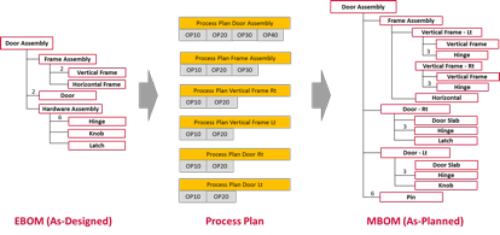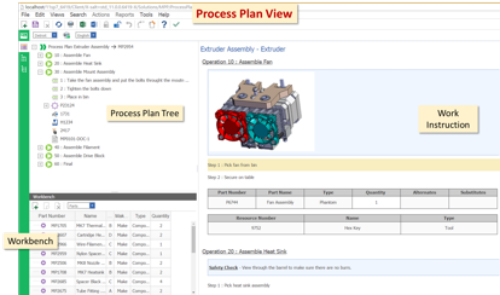Key takeaways:
- The lack of integration between EBOM, MBOM, manufacturing process planning, and work instructions results in information silos that create gaps in traceability and make it difficult to keep data synchronized—directly impacting product cost, quality, and time to market
- Automating the transformation of the Engineering Bill of Material (EBOM) to Manufacturing Bill of Material (MBOM) is a goal of many Product Lifecycle Management (PLM) implementations, yet few fully automated solutions exist due to complexities of the transformation
- Improving the connection between product development and manufacturing data is a key enabler for digital thread and digital
- Aras’s new Manufacturing Process Planning solution leverages the Aras single platform architecture to enable a solution that automatically derives the MBOM from a manufacturing process plan and maintains as-designed to as-planned traceability
Introduction
Process planning is a function within a manufacturing organization that defines the processes used to physically produce a product. Processes can be as simple as purchasing a component from a supplier, or as complex as defining a detailed sequence starting with raw material acquisition through machining, heat treating, and other finish work. Assembly processes can include components such as adhesives, electronics, and software. The data within a process plan can be complex and diverse. Typically, as a process plan is being created, the required MBOM is derived from the EBOM.
Figure 1 shows a simple example of how the items within an EBOM are restructured in an MBOM as the process plan is created. The MBOM represents data fundamentally differently from the EBOM. The EBOM commonly has components structured by product function, e.g. all the hardware is contained in a subassembly. The MBOM represents data from the view of how it will be manufactured and assembled. For example, hinge hardware is consumed in four different manufacturing steps. Identifying at which level of hierarchy an item gets consumed requires manufacturing process knowledge; and reconciling that all EBOM items are consumed gets complex when changes happen in disconnected systems.
In addition to process plans, work instructions—detailed documentation describing how to execute tasks to produce a product—are necessary to support efficient shop floor operations and ensure product quality. Work instructions are most often a mix of text and graphics. More advanced production cells have electronic access to work orders that describe the items to be produced, work instructions and any other relevant information needed to fulfill the work order.

Figure 1—EBOM and MBOM for a Door Assembly
(Courtesy of Aras Corporation)
Digital Thread
At many CIMdata clients a key PLM related goal is the integration of product development with manufacturing via digital data—often called a digital thread. Techniques such as automated EBOM-MBOM transformation support the digital thread and are employed to try to shorten the timeline and improve product quality. But even at more advanced clients, those with a digital twin vision (complete, connected, digital definition of the product, how it functions, and how it is manufactured), there are still gaps with manual tasks across the lifecycle, especially within the transfer of information to manufacturing. Since these gaps occur later in the product lifecycle, they can have a negative impact on quality, time to market, and profitability. The scale of the problem increases dramatically as product complexity increases.
Manufacturing Process Planning from Aras
To help deal with these issues Aras recently released a new solution for manufacturing process planning. Available for both Aras Innovator subscribers and open users, the Aras Manufacturing Process Planning Application (MPP) provides process plan authoring capabilities that simultaneously create the MBOM and process plan from the EBOM. The technology was developed to support large manufacturers such as GE who has publically reviewed their success with the solution’s predecessor. In the new solution, the process plan “consumes” the EBOM within the manufacturing process plan and outputs an MBOM. The MBOM is structured in the order of consumption and adds in the non-EBOM items including phantoms, consumables, tooling, and other needed resources. The EBOM, process plan and MBOM are fully integrated within the same data structure. As was the case with GE, the solution can be deployed alongside an existing legacy PLM system, avoiding the need for a disruptive and expensive “rip and replace” implementation.
Figure 2 shows the MPP user interface displaying the process plan view. The workbench area in the lower left can display different resources including EBOM parts, equipment and skills. On the right, the work instruction is created concurrently with the creation of the process plan and can include models, drawings, pictures, graphics, videos, and text controlled by Aras Innovator. The process plan is created and edited using drag and drop from the workbench to the tree view in the upper left.

Figure 2—Process Planning View within the Aras MPP Solution
(Courtesy of Aras Corporation)
Since MPP is built on the Aras Innovator platform it shares the same flexible data model as other applications. By referencing the EBOM, change impacts can be identified and managed. Version control can be enabled on MBOM, process plans, work instructions, and other items, improving digital thread traceability across the lifecycle. For example, if an EBOM is modified to increase the quantity of fasteners, the MBOM will display a reconciliation error identifying the unconsumed fasteners. Process plans can also be linked to quality documents such as process failure mode and effects analysis (PFMEA) and inspection and test control plans.
CIMdata has been promoting the concept of a Bill of Information (BOI)—a linked structure of all product definition data—for many years, and the MPP solution from Aras supports this concept by linking product development with manufacturing leading to improve traceability. For example in an Industry 4.0 environment, suppose the Industrial Internet of Things (IIOT) interface to the manufacturing floor indicates a machining center is having difficulty maintaining a tolerance on a part. A manufacturing engineer would be able to navigate the digital thread from the work instruction to the PFMEA, from there to the MBOM, to the EBOM, to the original design to investigate the issue. In most organizations, tracing through the data would be a painful task, since it exists in multiple systems. With the platform-based approach from Aras a proper BOI connected to the shop floor becomes much easier for closed loop processes.
The Aras MPP solution provides many benefits to manufacturing companies. CIMdata sees three key advantages enabled by Aras’ MPP solution that can dramatically improve global manufacturing operations, particularly for complex products or systems. The reconciliation function ensures that all components in the EBOM are consumed in the MBOM and graphically indicates potential issues to manufacturing, such as when an item is currently part of an active change process. By tightly integrating the MBOM with the EBOM, changes flow easily to avoid rework situations, and since MBOMs are full resolved and structured as ERP expects to receive them, few if any manual modifications are required. Perhaps the most important capability is change impact analysis. Since MPP enables all the data from design through production to be linked, whether managed in Aras or federated from other existing systems, the impact of changes can be quickly and easily assessed, with confidence that all the impacts are identified.
Conclusion
EBOM to MBOM integration is a capability needed by many manufacturers to reduce errors and improve the speed of transferring products into manufacturing. Manufacturing process plans and work instructions typically operate in silos that are disconnected from product development. Connecting them can have significant impact on manufacturing cost and quality and can even result in reduced risk of recalls, especially in regulated industries. In addition, better product development to manufacturing integration can shorten time to market and enable new capabilities such as the digital twin.
Aras’s MPP application provides a solution to manage the EBOM to MBOM transformation. By using a manufacturing process plan to derive the MBOM, data integrity can be preserved and EBOM changes propagated to the process plan, MBOM, and work instructions. Manual work that has to be repeated for every change or variant is automated, reducing time spent, minimizing errors, improving quality, and lowering cost.
Aras subscribers that need to support manufacturing should evaluate MPP since it is included within their subscription. Companies that need to support complex manufacturing processes should also investigate the solution as the tight EBOM to MBOM linkage, process planning, and work instruction capabilities can have a significant impact on meeting operational requirements.




